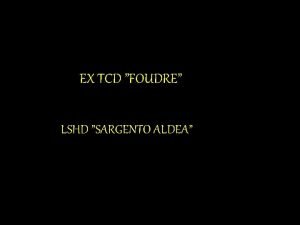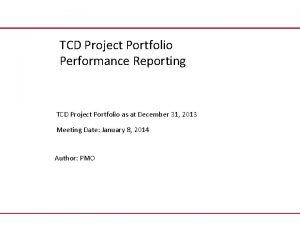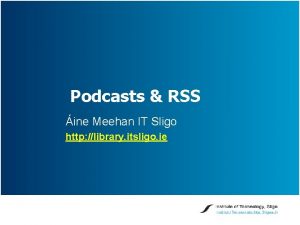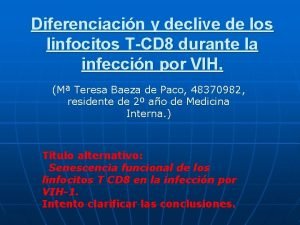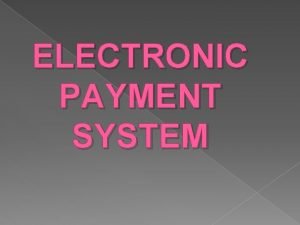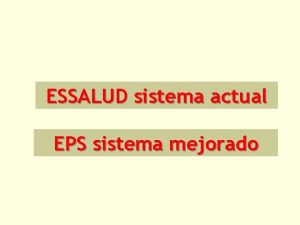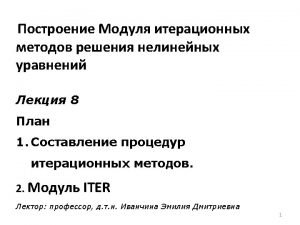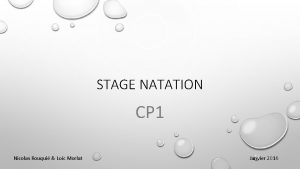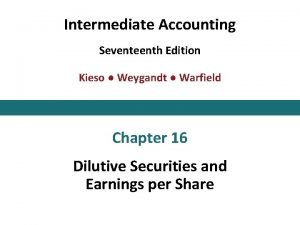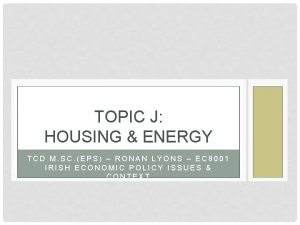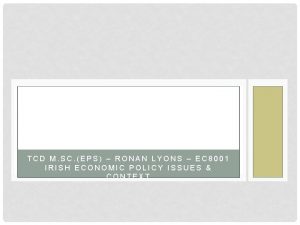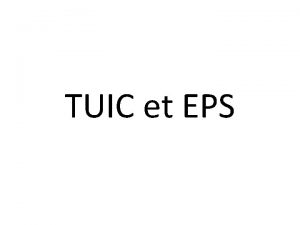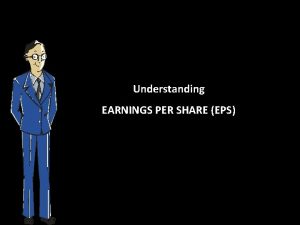TOPIC G REGULATION COMPETITION TCD M SC EPS


















































- Slides: 50

TOPIC G: REGULATION & COMPETITION TCD M. SC. (EPS) – RONAN LYONS – EC 8001 IRISH ECONOMIC POLICY ISSUES & CONTEXT

MODULE OUTLINE Topic Title Eo. I Ch Dates A Irish Economic History to Independence 1+ MT 1 -2 B Irish Economic History since Independence 1+ MT 3 -4 C The Economy & Economic Growth 2, 7 MT 5 -6 D Public Finances, Debt & Taxation 3, 4 MT 8 -9 E The Labour Market 6 MT 10 -11 F Social Justice & Inequality 8 HT 1 -2 G Regulation & Competition 5 HT 3 -4 H Competitiveness & Trade 9, 11 HT 5 -6 I Health & Education 12, 13 HT 8 -9 J Natural Resources & Real Estate 10, 14* HT 10 -11

READING & DATA • Economy of Ireland, Ch. 5 • Other readings • • World Bank Doing Business project/dataset EU Smart Regulation/Impact Assessment website Forfás Review of the Retail Cap in Ireland (2011) National Consumer Agency review of consumer behaviour survey (2013) • Dublin City Council Development Plan (in particular 2011 -2017)

TOPIC G: STRUCTURE Regulation & Competition 1. 2. 3. 4. 5. Goals & Means Costs & Benefits Competition Policy Natural Monopolies Irish Case Studies

AIM OF REGULATION CLEAR • Ultimate aim of regulation is clear and simple: • To contribute to achieving the highest standard of living for the people Ireland – the primary responsibility of government • Regulation covers a variety of spheres • • • Economic Social Political Cultural Medical …

GOALS MAY OVERLAP & CONFLICT • E. g. (1) support for Irish language • Culturally (and politically) important • Socially, may exclude “New Irish” • Economically, opportunity cost of money spent on Irish • E. g. (2) stem cell research • Medical regulation • Social/religious motivations • Goals of regulation need not be evidence-based • Nuclear power (vs. turf, coal, other fossil fuels) • GMO foods (in context of global malnutrition)

IS GMO DEBATE EVIDENCE-BASED? ! • GMO foods

DIFFERENT TYPES OF REGULATION Control-based: “You must (not)…” Information-based: “Did you know that…? ” Incentive-based: “As long as …, you’re free to…”

ECONOMIC AIMS OF REGULATION • Reducing set of legal outcomes to socially acceptable subset (control regulations) • Reducing imperfect information (info regulations) • Aligning marginal cost and marginal revenue (competition policy) • Aligning private and social costs (externality-based taxes, subsidies) • Overcoming behavioural biases (behavioural economics units)

CONTROL-BASED • Government created to protect “life, liberty and the pursuit of happiness”, and arguably property • Activities that deny others these ‘unalienable rights’ typically banned by government • Punishments include loss of property (fines), liberty (jail), life (execution)… • Society’s agreement on some activities – such as murder, assault, burglary – is easy • Significantly more difficult in other areas, e. g. the criminalization of homosexuality in Ireland • Cf. goals of regulation – social vs. cultural vs. religious • Many lesser examples, e. g. traffic lights

CONTROLS ARE UBIQUITOUS

INFORMATION-BASED • Much of the gap between economic theory and economic reality stems from imperfect information • Missing information: important attributes would not otherwise be measured (e. g. BER rating, NCT for cars) • Information imbalance: if purchaser has more information than seller (e. g. application for a business loan), service may be underprovided – ~Pigovian tax (to correct undersupply) • Disclosure requirements: ingredients, financial “tied agents”, APR, drug side-effects… • Name-and-shame: FSAI closure orders, tax defaulters, bankruptcies…

INCENTIVE-BASED • As per topic D (Public Finances), principal incentives are via Pigovian taxes and subsidies Positive externality € • E. g. of taxes: petrol, tobacco, alcohol • E. g. of subsidies: vaccines, education, media P=MC P=SMC • Tax and subsidies need not be regressive • E. g. of Swiss speeding law: % of income • Cf. two sets of prices – absolute (€), relative (%) D Q 0 Q 1 Q Without Pigovian subsidies, market will under-provide (i. e. misallocate society’s scarce resources)

INCENTIVE-BASED 2. 0 • A new generation of incentive-based regulations stem from psychology and behavioural economics • Reflects (non-cost) aversions and biases • Examples of these include: • • • Risk aversion Loss aversion Ambiguity aversion Status quo bias Inattentiveness • Cf. growing number of “Nudge” policymaking units • E. g. opt-out pension contributions or organ donation; redesigned tax forms

IRISH CONSUMERS EXHIBIT INERTIA Survey respondents who had switched service provider within previous 12 months 25% Those most likely to exhibit inertia include older people and those unaware of/not confident about their rights 20% 15% 10% Mortgage Life Insurance Non-mortgage Credit card Savings A/C Current A/C Gas supply TV service Health insurance Fixed line Electricity Waste provider Home insurance Mobile phone Broadband Top-up grocery Gym Car insurance 0% Main groceries 5% Source: National Consumer Agency

INFORMATION-BASED 2. 0? • Less profile than “nudge” policies has been next generation of information regulations • In Ireland, e. g. of property price register • Calorie count laws: • 2009 law in NY (now in CA): chains of more than 15 outlets – fine of $2, 000

TOPIC G: STRUCTURE Regulation & Competition 1. 2. 3. 4. 5. Goals & Means Costs & Benefits Competition Policy Natural Monopolies Irish Case Studies

SUBSTITUTABILITY OF MEANS • Suppose policymakers agree to reduce childhood obesity and target sugary drinks • Control-based: ban on sale of sugary drinks to U 18 s • Information-based: inclusion of sugar content on drink labels • Incentive-based: sugar tax based on social cost • Bearing in mind ultimate goals of policymaking and government (“life, liberty & pursuit of happiness”), which is the optimal tool? • Effectiveness vs. appropriateness • Cf. Singapore’s chewing gum ban (& $500 fine) • Is there also complementarity across means?

CHILDHOOD OBESITY • What is the rationale for regulation? • Why does it trump “pursuit of happiness”? • Cf. responsibilities of healthcare system • Immediate vs. long-run health effects • Who pays? Behavioural issues… • Assuming all three policies deliver same benefits, which costs least?

EU IMPACT ASSESSMENT • European Commission assess the impact of EU policies, legislation & trade agreements • At all stages: planning, implementation and review • Before: • Roadmaps describing planned initiatives • Commission impact assessments • After: • Initiatives are evaluated against goals • Simplification, reduction of regulatory burden through REFIT (Regulatory Fitness and Performance Programme) • Similar measures required at Member State level

COSTS OF REGULATION • Direct: • Regulatory charges (clear – but burden may not be) • Substantive compliance costs (one-off or recurring – BER vs. NCT) • Administrative burdens (e. g. information requirements) • Hassle costs (harder to measure, e. g. time wasted) • Indirect: • Changes in price, quantity or quality of goods • Reduced competition, market access, investment, innovation • Enforcement: • Monitoring, enforcement, adjudication

BURDEN OF REGULATORY CHARGES 1. Inelastic demand 2. Elastic demand S+ τ € S S P 2 P 1 D tax τ Q 2 Q 1 With inelastic demand, a charge on sellers will fall mainly on buyers: τ is similar to p 2 -p 1 D tax τ Q Q 2 Q 1 Q With elastic demand, buyers have other options, so a charge on sellers will cause a change in Q, not P

EU MAP OF REGULATORY IMPACTS

8% 7% 6% 5% 4% 3% 2% 1% 0% Hungary Greece Poland Spain Italy Austria Slovakia Portugal Slovenia Netherlands Germany France Czech Rep Belgium Ireland Denmark UK Sweden Finland REGULATORY COSTS CAN BE LARGE Administrative burden in 2003 (as % of GDP, estimated)

COSTS OF SETTING UP A FIRM % of per capita income 0 Australia Austria Belgium Canada Chile Czech Rep Denmark Estonia Finland France Germany Greece Iceland Ireland Israel Italy Korea Netherlands New Zealand Norway Poland Portugal Slovak Rep Slovenia Spain Sweden Switzerland UK Average 5 10 15 20 25 2005 2015

ENFORCING CONTRACTS Number of days 0 Australia Austria Belgium Canada Chile Czech Rep Denmark Estonia Finland France Germany Greece Iceland Ireland Israel Italy Korea Netherlands New Zealand Norway Poland Portugal Slovak Rep Slovenia Spain Sweden Switzerland UK Average 400 800 1200 1600 2005 2015

DISTRIBUTIONAL IMPACT • Costs of regulation may vary by stakeholder • • • Citizens and society as a whole Consumers Businesses Public Administrations “Third countries” • Transfers vs. net losses • As may benefits • Improved well-being (health, safety environment) • Improved market efficiency (cost, range, information) • Indirect benefits

WHEN DOES A FINE BECOME A PRICE?

TOPIC G: STRUCTURE Regulation & Competition 1. 2. 3. 4. 5. Goals & Means Costs & Benefits Competition Policy Natural Monopolies Irish Case Studies

COMPETITION POLICY “People of the same trade seldom meet together, even for merriment and diversion, but the conversation ends in a conspiracy against the public, or in some contrivance to raise prices” Adam Smith, The Wealth Of Nations (IV. 8)

COMPETITION POLICY • Administered at Irish and EU levels • Competition Authority of Ireland (now part of Competition & Consumer Protection Commission) • DG COMP • Legal basis is Articles 101 -109 of TFEU: • Cartels, collusion & other anti-competitive practices • Preventing abuse of ' dominant market positions • Control of proposed mergers, acquisitions [needs to exceed certain amount of EU turnover] • State aid given by Member States to companies • Companies need not be based in EU to be subject to its competition law

WHAT IS THE RATIONALE FOR THIS?

ECONOMIC AIMS OF REGULATION • Reducing set of legal outcomes to socially acceptable subset (control regulations) • Reducing imperfect information (info regulations) • Aligning marginal cost and marginal revenue (competition policy) • Aligning private and social costs (externality-based taxes, subsidies) • Overcoming behavioural biases (behavioural economics units)

ROLE OF COMPETITION POLICY • Encourage the existence of competitive markets • This often requires the regulation of activities of firms with significant market power • Prevention of mergers of two large competitors • P=MC means allocative efficiency – value placed by society equals cost to society • “Correct” amount produced (assuming no externalities) • P>MC: too little produced • Also rent-seeking behaviour – designed to protect market power

MEASURING THE MARKET • How do you decide the limits of the market? € • Some are well defined • Ervia vs. SSE vs. Electric Ireland… but what about home heating oil? • Others are much tougher Elasticity & Market power DPC • Hotel chain in Ireland… • B&Bs? Hotels in England? Cruises? Electric Picnic? DM • In practice, could firm raise prices by 5%/10% for a year? Q • Elasticity of demand cental

IS ACTUAL COMPETITION NEEDED? • Competitive markets vs. contestable markets • Do you need a large number of firms to keep price close to MC? • Example of Airbnb • If it decided to treble its fees due to its dominant market position, what would happen?

IN DEFENCE OF MONOPOLIES… • Human taste for diversity (e. g. restaurants, authors; monopolistic competition) • Necessary short-term reward for long-term competition (e. g. ICT) • May be associated with innovation, R&D (e. g. pharmaceuticals) • Economies of scale: what if socially most appropriate number of firms is one?

TOPIC G: STRUCTURE Regulation & Competition 1. 2. 3. 4. 5. Goals & Means Costs & Benefits Competition Policy Natural Monopolies Irish Case Studies

WHY AREN’T THERE MORE (GLOBAL) FACEBOOKS? Registered users (m) 1, 800 1, 600 1, 400 1, 200 1, 000 800 600 400 200 0 Google+ Facebook Twitter Qzone Sina Weibo Habbo Vkontakte

NATURAL MONOPOLIES • Defining characteristic: more efficient production by one firm than by many • Extreme case of market failure • Examples include transmission networks and grids • • • Electricity transmission Natural gas Broadband network Rail network Water transmission

NOT BLACK AND WHITE • What about the following? • Postal service • Bus service • Waste collection: • Option A: open competition (wasteful duplication? ) • Option B: state monopoly • Option C: break up geographic markets, monopoly in each (but competition nationally)

NATURE OF THE COST CURVES • With economies of scale, average cost falls as quantity provided rises • This means that marginal cost must be below average cost • Fixed costs dominate over variable costs • Sector-specific regulation (regulator) • Commission for Energy Regulation • Commission for Aviation Regulation • Commission for Communications Regulation • In some instances, price-setting powers • E. g. CPI-X approach (declining real prices – increased efficiency? )

POLITICAL TASTES • Since 1980 s, move away from State ownership of natural monopolies • Separation and privatisation of contestable activities • Promotion of competition • Cf. Topic D (Public finances): New. ERA • Aim is to dispose and restructure state-owned enterprises: ESB, Ervia (incl. Irish Water), Eir. Grid, Bord Na Mona, Coillte • Other State organisations: VHI, An Post, Aer Rianta, BIM, DAA, SOLAS, National Lottery, RTE, TG 4…

TOPIC G: STRUCTURE Regulation & Competition 1. 2. 3. 4. 5. Goals & Means Costs & Benefits Competition Policy Natural Monopolies Irish Case Studies

DEVELOPMENT STANDARDS • Why would anyone oppose higher building standards? • Roughly € 75 extra month in break-even rent 2 -bed Denmark • € 1500/m 2 means € 15, 000 for extra space 1 -bed France • What is the cost per sqm? Convert that into a monthly rent… Ireland • What is the impact on break -even rents? 90 80 70 60 50 40 30 20 10 0 Dublin • E. g. DCC’s 55 m 2 minimum size for 1 -bed Minimum size requirements for units

THE MINIMUM WAGE • Rationale for a minimum wage? Minimum wage € SL • Unequal bargaining power? Cf. illegality of selling kidneys w=w* • Benefit of minimum wage legislation • For some, redistribution of surplus from firm to worker • Cost of min wage • For some, unemployment – price floor mechanism DL Q 1 Q 0 Q 2 Q

THE RETAIL CAP If the retail caps were abandoned… Effect on competition Retailers Customers Urban Rural Greater? Less? Lower margins for all? Employment effect? Higher margins for survivors? Reduced prices? Ambiguous?

THE BANKING CRISIS • Root issues: • 1995 -2007 – Lack of regulation (misunderstood nature of financial sector within EMU) • 2007 -2010 – No ability to distinguish solvency from liquidity • Generalist Cabinet Ministers & civil servants • Unlike Executives in other countries (e. g. US), and administrations in many other countries • Where does the expertise from? • Not an exclusively Irish problem • But Ireland also the only country to offer unlimited bank guarantee… • Importance of minimum possible barriers between public and private sector labour forces

RECAPPING… • Economic just dimension to regulation: social, cultural, political. . . • Control, information, incentive based rules • Assessing the impact: RIA, EU frameworks, World Bank • Competition policy, natural monopolies • - market definition, elasticity of demand • Plenty of Irish case studies!

ESSAY & EXAM-STYLE QUESTIONS 1. “Those who oppose regulation are placing the interests of producers ahead of those of consumers. ” Discuss. 2. “Ireland should reduce its administrative burden by 25% between now and 2020. ” How would this take place in practice? Do you agree? 3. Analyse the regulatory structure, including rationale and policy recommendations for one of the following: 1. The cap on the size of retail stores 2. The Irish banking crisis 3. Development standards for new apartments
 Monopoly vs monopolistic competition
Monopoly vs monopolistic competition Monopoly vs oligopoly venn diagram
Monopoly vs oligopoly venn diagram Competition refers to
Competition refers to Lump sum subsidy monopoly
Lump sum subsidy monopoly Trinity bess points
Trinity bess points Tcd foudre
Tcd foudre Trinity inclusive curriculum
Trinity inclusive curriculum Tcd
Tcd Emanuel coman tcd
Emanuel coman tcd Tcd project management
Tcd project management Tcd harvard referencing
Tcd harvard referencing Netsoc tcd
Netsoc tcd Tcd tpd
Tcd tpd What is bess in trinity
What is bess in trinity Michael king dublin
Michael king dublin Rachel hoare
Rachel hoare Tcd orage
Tcd orage Tcd disability service
Tcd disability service Student learning tcd
Student learning tcd It sligo library
It sligo library Niamh brennan tcd
Niamh brennan tcd Tcd 8
Tcd 8 Clincher ideas
Clincher ideas Narrowed down topic examples
Narrowed down topic examples Eps foam pro
Eps foam pro Actual eps
Actual eps Eps tracker online
Eps tracker online Meaning of payment system
Meaning of payment system Sapos eps
Sapos eps Moray dewhurst
Moray dewhurst Eps 10 cm
Eps 10 cm Partes de un perfil
Partes de un perfil Electronic prescription tracker
Electronic prescription tracker Pronote lycée jean moulin albertville
Pronote lycée jean moulin albertville Quejas eps sanitas
Quejas eps sanitas Essalud periodo de latencia
Essalud periodo de latencia Epi eps
Epi eps Eps
Eps Eps clermont ferrand
Eps clermont ferrand Reactor for eps material
Reactor for eps material Nicolas rouquie eps
Nicolas rouquie eps What is an enterprise payment system
What is an enterprise payment system Eps token
Eps token Elipse diagrama de flujo
Elipse diagrama de flujo Course de haies eps
Course de haies eps Eps aubonne
Eps aubonne Pack eps paris
Pack eps paris How to calculate diluted eps
How to calculate diluted eps 4000000x5
4000000x5 Insulfoam anchorage
Insulfoam anchorage Rassdat eps
Rassdat eps





